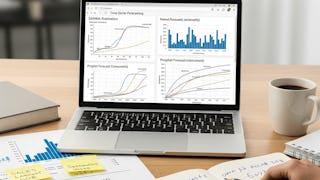By the end of this course, learners will be able to summarize datasets using descriptive statistics, visualize distributions with Python, evaluate probabilities, test hypotheses, and build regression models for predictive analysis. This hands-on training equips learners with the ability to apply statistical thinking to real-world data science projects, ensuring they can analyze, interpret, and present data effectively.



Statistics for Data Science with Python
This course is part of Python for Data Science: Real Projects & Analytics Specialization

Instructor: EDUCBA
Access provided by National Research Nuclear University MEPhI
What you'll learn
Summarize datasets with descriptive stats and visualizations.
Apply probability concepts and test hypotheses with Python.
Build and evaluate regression models for predictive analysis.
Skills you'll gain
Details to know

Add to your LinkedIn profile
12 assignments
October 2025
See how employees at top companies are mastering in-demand skills

Build your subject-matter expertise
- Learn new concepts from industry experts
- Gain a foundational understanding of a subject or tool
- Develop job-relevant skills with hands-on projects
- Earn a shareable career certificate

There are 3 modules in this course
This module introduces learners to the foundations of data science and statistics. It covers essential concepts such as measures of central tendency, dispersion, and correlation, while also demonstrating how to represent data visually through histograms. Learners will gain practical experience with Python tools like Pandas and NumPy to perform descriptive statistical analysis, making it easier to interpret and organize real-world datasets.
What's included
9 videos4 assignments1 plugin
This module explores probability fundamentals, event analysis, and hypothesis testing as cornerstones of statistical inference. Learners will calculate probabilities, analyze exclusive and independent events, and evaluate test scenarios using real data. By mastering p-values, denominators, and test statistics, learners will build strong analytical skills for interpreting uncertainty and validating data-driven assumptions.
What's included
9 videos4 assignments
This module focuses on regression techniques for modeling relationships between variables. Learners will begin with the basics of regression outputs, then progress to fitting models with multiple explanatory variables, analyzing residuals, and validating assumptions. Advanced topics such as curve fitting and interpreting coefficients and intercepts will equip learners to design accurate predictive models for real-world applications.
What's included
6 videos4 assignments
Earn a career certificate
Add this credential to your LinkedIn profile, resume, or CV. Share it on social media and in your performance review.
Why people choose Coursera for their career









